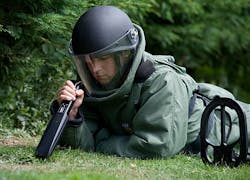L-3 developing handheld explosives detection combining metal sensor and ground-penetrating radar
Officials of the U.S. Army Contracting Command at Fort Belvoir, Va., announced their intention this week to award a contract for L-3 SDS to move forward with the Next Generation Handheld Multi-Sensor Explosive program to help the military detect roadside bombs and other improvised explosive devices (IEDs).
L-3 SDS engineers will continue developing an experimental handheld system that can detect explosive hazards like land mines, deeply buried metallic and non-metallic IEDs, as well as triggering mechanisms like wires and other conductive components.
The company specializes in explosives-detection, metal detectors, personnel and cargo screening, X-ray systems, and similar IED-detection technologies for airport, border, and perimeter security applications.
The Army Contracting Command is negotiating a contract with L-3 SDS on behalf of the Army Night Vision Electronics Sensor Directorate of the Army Research, Development and Engineering Command's Communications Electronics Research, Development, and Engineering Center.
Related: IED hunters adapt to sophisticated threats
Army researchers are working with L-3 SDS on a special initiative to design user-friendly easily maintainable explosive detection systems that combine metal-detection sensors, ground-penetrating radar, and other sensor technologies in a unit that one soldier can use without help.
L-3 SDS experts will continue developing a handheld explosive hazard-detection technology demonstrator that the company developed previously, Army officials say. L-3 SDS will improve the demonstrator's ability to detect explosive hazards, reduce the unit's false-alarm rate, shrink the unit's size, and make it easier to use.
The value of the upcoming 18-month contract to L-3 SDS has yet to be negotiated.
For more information contact L-3 SDS online at www.sds.l-3com.com, or the Army Night Vision Electronics Sensor Directorate at www.nvl.army.mil.

